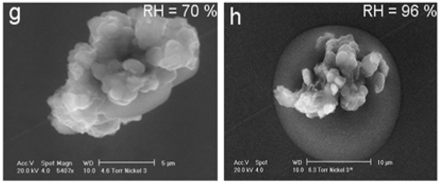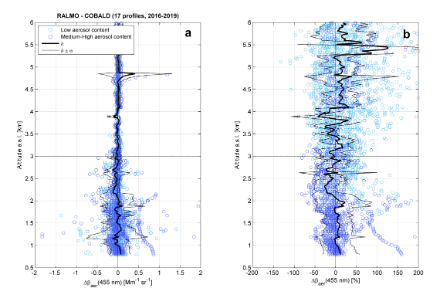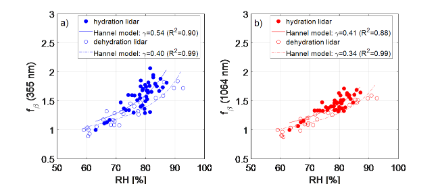Service Navigation
Search
Study of aerosol hygroscopic effect on optical and microphysical properties by means of remote sensing techniques (AEROHYGROPRO).
AEROHYGROPRO is a project funded through the AMBIZIONE program of the Swiss National Science Foundation. The general objective of this project is to contribute to the advancement of the atmospheric aerosol research, in particular on those aspects related with the aerosol hygroscopicity and their effect on the scattering of the radiation. The response of specific aerosol properties to variations in relative humidity is critical to determine the influence of the aerosol on climate. This project aims to characterize the effect of hygroscopicity on optical and microphysical properties of different types of aerosols using remote sensing techniques. The Swiss RAman Lidar for Meteorological Observations (RALMO) operated at the aerological station of MeteoSwiss at Payerne is the main tool for this characterization. RALMO can provide continuous daytime and nighttime profiles of aerosol properties (backscatter and extinction) and relative humidity.

Aerosol and relative humidity profiles from Raman lidar.
The combination of vertical information of aerosol properties and relative humidity are essential to address the characterization of aerosol hygroscopic properties. RALMO is a state-of-art humidity and aerosol profiler capable to measure the rotational-vibrational Raman signals of nitrogen and water vapour (wavelengths of 386.7 and 407.5 nm, respectively) along with the pure rotational Raman (PRR) signal around the Rayleigh line at 355 nm during day and night-time. These signals allow, by means of different inversion algorithms, to retrieve vertical information of aerosol backscatter and extinction coefficients at 355 nm and relative humidity. Aerosol spectral information is gained by the use of a co-located ceilometer, which provides aerosol backscatter profiles at the infrared range (1064 nm).
A validation of the aerosol and RH profiles from the lidars is addressed in this project by comparing with independent in-situ airborne measurements. The accuracy and precision of RH measurements from the lidar have been evaluated using the operational SRS-C50 sondes, while the aerosol backscatter profiles retrieved from RALMO and the ceilometer have been evaluated with the newly developed balloon-borne backscatter sonde COBALD (Compact Optical Backscatter and Aerosol Detector) developed by ETH Zurich. COBALD uses two high power (250 mW) LEDs at wavelengths centred at 455 nm (blue) and 870 nm (infrared). A silicon detector measures the light scattered back at both wavelengths by air molecules, aerosol particles or cloud droplets and ice crystals. These COBALD sondes allow a unique evaluation of the accuracy of the lidar technique under large variety of aerosol types.

Analysis of aerosol hygroscopicity.
The Ralmo measurements allow us to monitor any change in aerosol properties that could occur as result of the water uptake by the particle under high RH (aerosol hygroscopic growth). To ensure that the changes in
the aerosol properties are due to hygroscopic growth and not to changes in aerosol mass loading or chemical composition certain requirements must be fulfilled. Well-mixed conditions are required within an investigated layer when aerosol hygroscopicity is analysed in the vertical. Slow-varying or constant values of water vapour mixing ratio (r) and potential temperature are used as proxy for this last requirement. For a temporal analysis r and wind measurements are used to guarantee that the air mass did not change. Once the previous requirements have been fulfilled the aerosol hygroscopicity is characterized by means of the backscatter enhancement factor (fα/β). This factor is defined as the ratio between the backscattering coefficient at enhanced relative humidity, RH, to a reference (dry) backscattering coefficient.

Statistical analysis of aerosol hygroscopic properties.
A statistical analysis of aerosol hygroscopic properties is being carried based on 3-year data set of Ralmo lidar. Based on a preliminary analysis we expect to find in the data set every year a high number of pollution events, 5-10 Saharan dust events, 10-15 biomass burning events and 0-2 volcanic ash events. This will allow for a robust determination of the enhancement factors for aerosols of types pollution, Saharan dust and biomass burning. Much higher uncertainty is expected for volcanic ash particles due to the much lower number of events.
Inter-comparison field campaign at the Payerne
An intercomparison campaign (HYGRO19) of two months has been organized at Payerne station with the goal of comparing the hygroscopic results from two different techniques (remote sensing and in situ). The campaign was carried out in summer 2019. Summer season presents stronger convective conditions allowing that the measurements at surface and in the column are more comparable. A tandem nephelometer built and operated by the Atmospheric Physics Group of the University of Granada (Spain) was installed in this station. Hygroscopic measurements from the tandem nephelometer and from Cobald sondes are compared with the ones from the Raman lidar.

Relevance and impact
This project will strongly contribute to the understanding of the hygroscopic effect on aerosol properties. The project exploits one of the largest data sets of simultaneous aerosol and humidity profiles that will allow a thorough statistical analysis based on a long-term time series and a robust determination of hygroscopic properties for a variety of particles never done so far. In particular, we will derive the enhancement factor for optical properties such as backscatter and extinction and microphysical properties as volume concentration which are very important parameters to characterize the direct and indirect effect of aerosols. As opposed to in-situ methods the lidar technique is non-invasive and allows studying the aerosols in their original environment. The importance for the climate system is evident from the IPCC-5 report (IPCC, 2013), where the indirect and the direct effect of aerosols make the two largest contributions to the total uncertainty of the radiative forcing. In this sense, this study will contribute to reduce the uncertainties in the direct and indirect aerosol effect on radiative budget by means of a better understanding of aerosol hygroscopic processes. Modelers will also benefit of the results derived from the project, since a better characterization of hygroscopic properties for different kind of particles will be included in the models improving the climate predictions.
Partners institutions
- Paul Scherrer Institute (Switzerland)
- University of Granada (Spain)
- EMPA (Switzerland)
- University of Applied Sciences Northwestern Switzerland FHNW (Switzerland)
- ETH Zurich (Swiss Federal Institute of Technology in Zurich, Switzerland)
Publications
Bedoya-Velásquez, A. E., F. Navas-Guzmán, M. J. Granados-Muñoz, G. Titos, R. Roman, J. A. Casquero-Vera, P. Ortiz-Amezcua, J. A. Benavent-Oltra, G. de Arruda Moreira, E. Montilla-Rosero, C. D. Hoyos Ortiz, B. Artiñano, E. Coz, L. Alados-Arboledas and J. L. Guerrero-Rascado: Hygroscopic growth study in the framework of EARLINET during the SLOPE I campaign: synergy of remote sensing and in-situ instrumentation, Atmos. Chem. Phys.,18, 7001-7017, https://doi.org/10.5194/acp-18-7001-2018, 2018.
Brunamonti, S., Martucci, G., Romanens, G., Poltera, Y., Wienhold, F. G., Haefele, A., and Navas-Guzmán, F.: Validation of aerosol backscatter profiles from Raman lidar and ceilometer using balloon-borne measurements, Atmos. Chem. Phys. Discuss., https://doi.org/10.5194/acp-2020-294, in review, 2020.
Martucci, G., Navas-Guzmán, F., Renaud, L., Romanens, G., Gamage, S. M., Hervo, M., Jeannet, P., and Haefele, A.: Validation of temperature data from the RAman Lidar for Meteorological Observations (RALMO) at Payerne. An application to liquid cloud supersaturation, Atmos. Meas. Tech. Discuss., https://doi.org/10.5194/amt-2020-289, in review, 2020.
Navas-Guzmán, F., Martucci, G., Collaud Coen, M., Granados-Muñoz, M. J., Hervo, M., Sicard, M., and Haefele, A.: Characterization of aerosol hygroscopicity using Raman lidar measurements at the EARLINET station of Payerne, Atmos. Chem. Phys., 19, 11651–11668, https://doi.org/10.5194/acp-19-11651-2019, 2019.